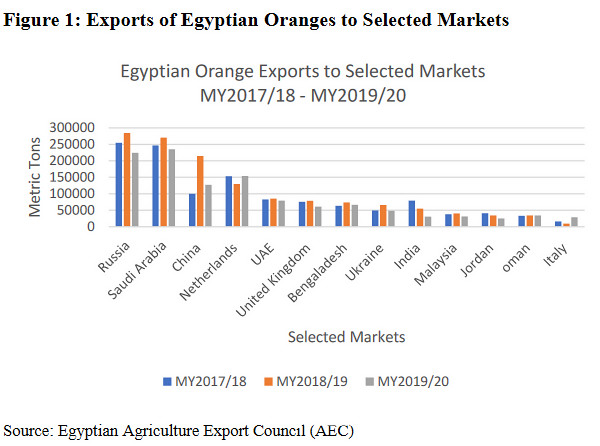Orange exports are set to rise to 1.5 million tons in the 2020/2021 season. In 2019/2020, it was 1.37 million. That's according to the US Foreign Agricultural Service (FAS) in Cairo. There should be more exports, thanks to increased cultivation under favorable weather conditions.
Saudi Arabia, Russia, the Netherlands, China, and the United Arab Emirates are likely to remain the main export destinations for oranges from Egypt. Recent new export destinations for these oranges include New Zealand, Japan, and Brazil. In 2019/2020, Egyptian orange exports decreased by 343.000 tonnes compared to the previous season. The COVID-19 pandemic is the main reason for this.

Harvested area will grow by 3.5%
In recent years, the Egyptian government, private enterprises, and growers continually try to improve this crop. They replace old orchards with newer ones and improve irrigation techniques. They have also adopted up-to-date nutrient management programs and reduce post-harvest losses. Orange is the most important citrus crop in Egypt. It accounts for about 80% of the total citrus area.
For 2020/2021, FAS Cairo has predicted a total planted orange area of 168,000 ha. That's roughly the same as in 2019/2020 when the planted area remained unchanged. Most of the orange-growing area is on reclaimed land. That represents 60% of the total area. Orchards in the Nile delta make up 40% of the total orange area.
The total harvested 2020/2021 area is an estimated 145.000 ha. That's 3,5% more than last year. This increase is attributed to there being seven percent more bearing trees than the previous year. The favorable weather conditions during the flowering period also helped. That benefited the trees flowering and, as a result, the yields.
Varieties
The top Egyptian orange varieties include the following:
Washington Navel: This is the most important navel orange cultivated in, and exported from, Egypt. There are other lesser-known navel orange varieties like Navelate, Cara Cara, New Hall, Navelina, Fisher, Leng, Fukumoto, and Lane late too. Washington Navels starts coloring at the end of September and ripen from November to March. This medium to large orange variety is seedless and sweet-tasting. The peel is orange, and it has dark flesh.
Valencia: Concerning cultivated acreage, this variety ranks second after the Navels. The Nubaria region is thought to have the most Valencia orchards in Egypt. Valencias have a long ripening period, from March to July. Its flesh is juicy, and this round/oval-shaped orange is medium to large in size. The soft peel peels easily, and it has small seeds.
Egyptian farmers grow other kinds of oranges too. These include Baladi, Blood, Khalily, Yafawy, and Sweet varieties. These cultivation areas are small compared to the Navel and Valencia orange farms.
Source: USDA
